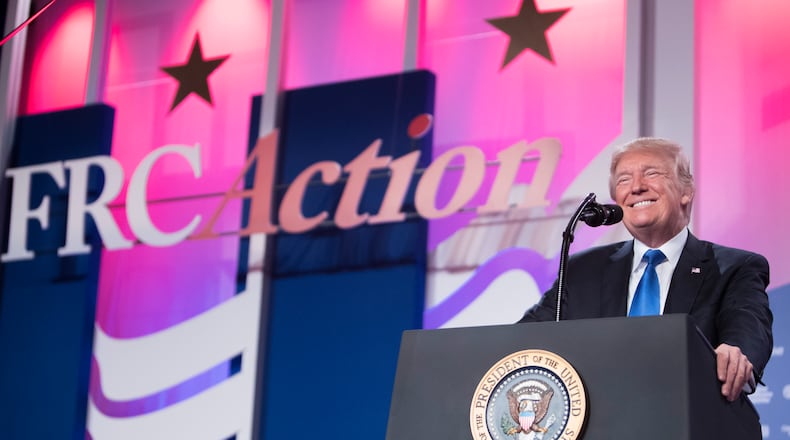“If the Senate can’t provide Americans with relief, then I’ll take matters into my own hands,” he said in a fundraising missive to supporters shortly after signing an executive order Thursday in the White House.
In a statement late Thursday, the White House press secretary called the cost-sharing subsidies “unlawful” and “yet another example of the previous administration abused taxpayer dollars and skirted the law to prop up a broken system.”
RELATED: Local providers get training to treat opioid addiction as disease
House Democratic Whip Steny Hoyer, D-Md., said Trump was undermining bipartisan attempts to improve the system.”
“Not content to harm Americans with pre-existing conditions with his executive order earlier today, this President is now acting spitefully to raise premiums on millions of Americans and force a collapse of our health insurance marketplaces,” he said. “The President seems to forget that he and his party will be held accountable for any changes that occur in our health care system on his watch.”
It’s unclear exactly how much the executive order will affect the marketplaces, but analysts see it further destabilizing an already shaky landscape.
People in this region who rely on health insurance bought through the Affordable Care Act exchange will be paying much more next year for coverage and have less plans to chose from.
The four remaining health insurers who will sell plans next year in the region — CareSource, Buckeye, Molina and Medical Health Insuring Corp. — will all have average premium rate hikes that are higher than the Ohio average rate hike of 34 percent.
For Ohio, the 34 percent average increase, means in 2018 the average individual premium will be up to $5,798.
RELATED: Ohio ACA plans to cost 34 percent more on average
In 2013, the weighted average premium for an individual market plan was $2,650.17.
The Ohio insurance department reported the average cost of insurance in the small group market has stayed level from 2017 to 2018 – with only an increase of one-half of one percent. Overall, the weighted average premium increased 84 percent from 2013 to 2018, from $4,041.66 to $7,444.34.
People who don’t want to buy the expensive plans won’t have a lot of options to chose from.
Darke County residents will only have one option to buy health insurance through the Affordable Care Act next year through Buckeye, and plans from the insurer will on average will cost about 50 percent more.
Miami County will only have one option through CareSource and overall the insurer’s average premiums will increases 36.5 percent.
RELATED: New CareSource office tower strengthens core of city
In Montgomery County, there were 10,486 people who bought insurance plan through the exchanges during open enrollment last year, with about a third of the plans sold to people between 55 and 64 years old.
People will need to enroll between Nov. 1 and Dec. 15.
While Trump’s decision will undoubtedly roil the marketplaces, key elements of the 2010 health care law remain: He has not undone the Medicaid expansion that Ohio Gov. John Kasich used to insure 725,000 more low-income Ohioans. Nor has he been unable to dismantle the centerpiece of the law: The requirement that the vast majority of Americans buy health insurance or face a tax penalty.
The 2010 law required insurers to offer plans with reduced deductibles and co-pays to marketplace enrollees whose incomes were within 100 to 250 percent of the poverty level. The Congressional Budget Office estimated the costs would be $7 billion a year in fiscal year 2017, rising to $10 billion in 2018 and $16 billion by 2027.
While leaving the market will save the federal government that money, the nonpartisan Kaiser Family Foundation argued in April that it will increase the costs for tax credits that subsidize premiums for marketplace enrollees with incomes of 100 to 400 percent of the poverty level. They estimated that the increased cost to the federal government of higher premium tax credits would actually be 23 percent more than the savings from eliminating cost-sharing reduction payments — a net increase of $2.3 billion in fiscal 2018, for example. Their study, however, assumes insurers will stay in the market if the subsidies end.
Here’s what some are saying about the executive order:
Tom Nickels, executive vice president of the American Hospital Association
“Today’s Executive Order will allow health insurance plans that cover fewer benefits and offer fewer consumer protections.”
Bloomberg News
The order isn’t as aggressive as it might have been in undermining the ACA, but that’s scant reassurance for insurers, who face an administration that seems actively hostile to a law it’s supposed to enforce. The order aims to let association health plans — groups of small employers banding together to buy insurance — offer coverage throughout the U.S. Insurers consistently oppose selling health insurance across state lines because of varying regulations.
Wall Street Journal
The impact of the order will take months to become clear, as federal agencies move the changes through the regulatory process. But actuaries and industry officials said the shift could create problems for insurers that offer plans under the Affordable Care Act, both to individuals and small businesses.
